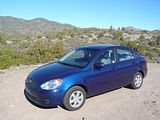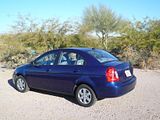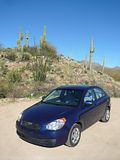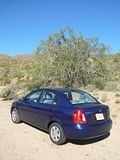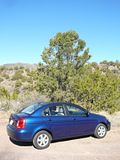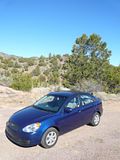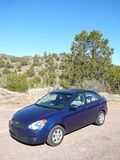After a fun week driving around in the latest Camaro and Challenger models, a watchful eye on the holiday budget suggested a need to return to something more prosaic, and nothing fits that description better than the subject of this report, Hyundai’s Accent. One of the cheapest cars available on the American market, the Accent fulfils a role not just as cheap new wheels for college kids and those on a tight budget, but it also forms the basis of the entry level category at many rental car companies. Accent is the name that was adopted in the 1990s by Hyundai for its sub-compact vehicle, replacing cars previously known and now long and deservedly forgotten as the Pony and XL or Excel. Launched in 1996, the first cars, known internally as X3 but bearing the Accent name in export markets, were unadventurous small hatchback and saloon cars unashamedly built down to a price and were pretty loathsome devices, but with each successive generation, the standard has improved and the third generation MC cars launched in 2006 received largely positive reviews and the coveted “recommended” status from the American Consumers Guide. In 2008, JD Power named the car as the most dependable in its class.
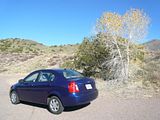
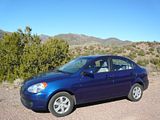
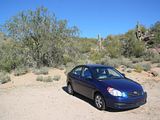
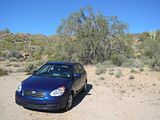
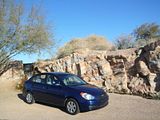
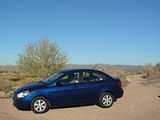 When launched at the 2005 New York Auto Show, as an American market 2006 model year car, the MC generation of Accent was presented solely as a four door saloon, and solely in GLS trim. In Spring 2006, a three door model, known as a Coupe in American parlance was added to the range and this car came initially in GS and SE trims. The GS version was trimmed in similar manner to the GLS Sedan, and was offered for just $10415. The SE had additional equipment and was intended to replace the faintly sporting GT model from the predecessor range. In 2010, Hyundai introduced a new lower priced 3 door model, called Accent Blue, which had different gearing aimed at improving fuel economy still further, and could not be specified with anything other than the 5 speed manual transmission. It listed at $9970, a saving of $2000 over the GS model. As with many cars these days, there is an element of complexity associated with a global view of the model. The same basic design has been assembled in Korea, China, Turkey, India, the Philippines and the Ukraine and in various markets around the world, has adopted names including Hyundai Verna, Accent Era, Brio and Avega as well as the Beijing Hyundai Accent and the Dodge Attitude. Unlike its predecessor, it was not sold in Europe, as those markets received the locally designed i30 hatchback instead.
When launched at the 2005 New York Auto Show, as an American market 2006 model year car, the MC generation of Accent was presented solely as a four door saloon, and solely in GLS trim. In Spring 2006, a three door model, known as a Coupe in American parlance was added to the range and this car came initially in GS and SE trims. The GS version was trimmed in similar manner to the GLS Sedan, and was offered for just $10415. The SE had additional equipment and was intended to replace the faintly sporting GT model from the predecessor range. In 2010, Hyundai introduced a new lower priced 3 door model, called Accent Blue, which had different gearing aimed at improving fuel economy still further, and could not be specified with anything other than the 5 speed manual transmission. It listed at $9970, a saving of $2000 over the GS model. As with many cars these days, there is an element of complexity associated with a global view of the model. The same basic design has been assembled in Korea, China, Turkey, India, the Philippines and the Ukraine and in various markets around the world, has adopted names including Hyundai Verna, Accent Era, Brio and Avega as well as the Beijing Hyundai Accent and the Dodge Attitude. Unlike its predecessor, it was not sold in Europe, as those markets received the locally designed i30 hatchback instead. 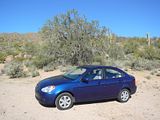

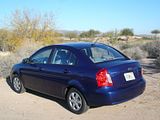

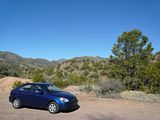
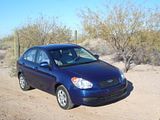 American market Accents were all delivered with a 1.6 litre 4 cylinder engine, developing 110 bhp. Coupled to a 4 speed automatic gearbox, you would not expect the Accent to be fast, and it is not. In traffic and on the freeway, it is fine, but it soon runs out of extra puff, as I found out on the hills of the test route. The engine is quite smooth and refined, though. At a freeway cruise, noise levels are not too bad, with some evidence of wind, tyre and engine, but all perfectly acceptable for this class of car. Work the engine that bit harder, though, such as climbing a long and moderate hill, and the engine noise increases a lot, especially if you have to go down a gear. The inclines on Route 87 north east out of Phoenix caused a downshift and the engine did get quite loud, though never all that rough. The transmission is of the old school style, with a simple PRNDL lever, with 4 speeds and no manual override. It did its job quite well, though, making smooth gearchanges up and down. Economy was reasonably good, with a test average of 31 mpg US (37 mpg Imperial). There is a plastic steering wheel which is the interface to a light steering set up, though I have certainly come across systems that were far lighter and far more devoid of feel. Handling was just as you would expect of a conventional small front wheel drive car, feeling safe, with a modicum of understeer evident on the tighter bends. The ride was good, and so were the brakes. A pull up central handbrake is fitted. A generous glass area, decently sized mirrors and a stubby tail meant that there no visibility issues and the car was particularly easy to manoeuvre in car parks.
American market Accents were all delivered with a 1.6 litre 4 cylinder engine, developing 110 bhp. Coupled to a 4 speed automatic gearbox, you would not expect the Accent to be fast, and it is not. In traffic and on the freeway, it is fine, but it soon runs out of extra puff, as I found out on the hills of the test route. The engine is quite smooth and refined, though. At a freeway cruise, noise levels are not too bad, with some evidence of wind, tyre and engine, but all perfectly acceptable for this class of car. Work the engine that bit harder, though, such as climbing a long and moderate hill, and the engine noise increases a lot, especially if you have to go down a gear. The inclines on Route 87 north east out of Phoenix caused a downshift and the engine did get quite loud, though never all that rough. The transmission is of the old school style, with a simple PRNDL lever, with 4 speeds and no manual override. It did its job quite well, though, making smooth gearchanges up and down. Economy was reasonably good, with a test average of 31 mpg US (37 mpg Imperial). There is a plastic steering wheel which is the interface to a light steering set up, though I have certainly come across systems that were far lighter and far more devoid of feel. Handling was just as you would expect of a conventional small front wheel drive car, feeling safe, with a modicum of understeer evident on the tighter bends. The ride was good, and so were the brakes. A pull up central handbrake is fitted. A generous glass area, decently sized mirrors and a stubby tail meant that there no visibility issues and the car was particularly easy to manoeuvre in car parks.
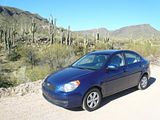
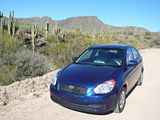
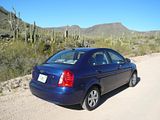
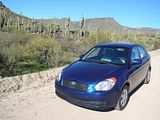
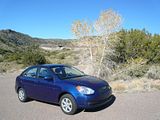 Unpretentious is the word I would use to describe the interior of the Accent. The dashboard and the door trims are a mixture with the upper half black, the lower half light grey. It all looks neat, but with no real flair. Poke a bit harder and the plastics are all very hard indeed, but the fit and finish is top notch, and that is probably all that the target buyers of a car like this are going to expect. Remember its price point! The main dials, which comprise large speedometer and rev counter straddling a smaller fuel gauge, are clearly marked and easy to read. A large satellite radio unit is mounted high up in the middle of the dash, and below this are the rotary dials for the air conditioning. Column stalks do lights (twist the end of the stalk), indicators and wipers, and there are repeater buttons for the audio unit on the spokes of the steering wheel, and that is it. Compared to the ever so fussy interiors of an increasing number of cars, there is a refreshing simplicity to this one. .
Unpretentious is the word I would use to describe the interior of the Accent. The dashboard and the door trims are a mixture with the upper half black, the lower half light grey. It all looks neat, but with no real flair. Poke a bit harder and the plastics are all very hard indeed, but the fit and finish is top notch, and that is probably all that the target buyers of a car like this are going to expect. Remember its price point! The main dials, which comprise large speedometer and rev counter straddling a smaller fuel gauge, are clearly marked and easy to read. A large satellite radio unit is mounted high up in the middle of the dash, and below this are the rotary dials for the air conditioning. Column stalks do lights (twist the end of the stalk), indicators and wipers, and there are repeater buttons for the audio unit on the spokes of the steering wheel, and that is it. Compared to the ever so fussy interiors of an increasing number of cars, there is a refreshing simplicity to this one. .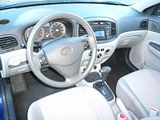
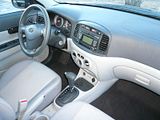
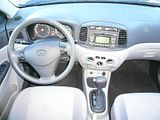
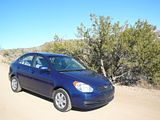
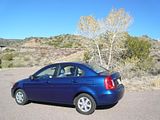
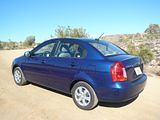 Seat adjustment is all manual, as you would expect. As seems to be favoured by Americans, the backrest adjuster allows you to alter the angle in a series of steps rather than being a continuum. The driver’s seat has a height adjuster on it too, by dint of a rotary knob on the side of the seat, but unfortunately as well as altering the height, it tips the seat forward or backwards, leading to a less than perfect driving position for me. The seat did prove comfortable, though, and there is a thin central armrest just for the driver, mounted on the side of the driver’s seat which can be swivelled up out of the way should you so desire (which I did). .
Seat adjustment is all manual, as you would expect. As seems to be favoured by Americans, the backrest adjuster allows you to alter the angle in a series of steps rather than being a continuum. The driver’s seat has a height adjuster on it too, by dint of a rotary knob on the side of the seat, but unfortunately as well as altering the height, it tips the seat forward or backwards, leading to a less than perfect driving position for me. The seat did prove comfortable, though, and there is a thin central armrest just for the driver, mounted on the side of the driver’s seat which can be swivelled up out of the way should you so desire (which I did). .



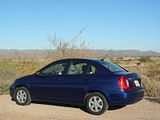
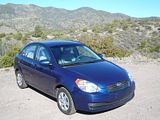 Although the rental car companies put the Accent in the very cheapest grouping that they have, it is not the smallest car on the market, and that is evident when you open the rear doors. Especially when the rear passengers get the benefit of sitting behind a short legged driver like me, there is a surprising amount of space. Headroom is just adequate, with my head not quite touching the roof. There are seat belts for three and with negligible intrusion from a transmission tunnel, they would fit though shoulder room might be at a premium. There is a drop down central armrest which has twin cupholders on its top face. The boot is a reasonable size, too, and can be extended by folding the rear seat backrests forward. A space saver nestles in a sizeable well under the boot floor, but this small wheel leaves quite a lot of space where you could put all those odds and ends that would otherwise roll around the boot. Like many cheap cars, the boot lid is single skinned and unlined, with some unpleasant looking screw ends, cables and sharp edges in the recesses of the panel. One of these is the cable for the remote release feature. Inside the cabin, there is a drop down glove box, door bins on all four doors which have a moulding to accommodate a bottle, a lidded cubby at the bottom of the centre of the dash, and a lipped area in front of the gearlever, which has a moulding for a cup, though there are two deeper cup holders further back in the centre console. Rear seat passengers have to make do with the door bins and a map pocket in the back of just the passenger seat.
Although the rental car companies put the Accent in the very cheapest grouping that they have, it is not the smallest car on the market, and that is evident when you open the rear doors. Especially when the rear passengers get the benefit of sitting behind a short legged driver like me, there is a surprising amount of space. Headroom is just adequate, with my head not quite touching the roof. There are seat belts for three and with negligible intrusion from a transmission tunnel, they would fit though shoulder room might be at a premium. There is a drop down central armrest which has twin cupholders on its top face. The boot is a reasonable size, too, and can be extended by folding the rear seat backrests forward. A space saver nestles in a sizeable well under the boot floor, but this small wheel leaves quite a lot of space where you could put all those odds and ends that would otherwise roll around the boot. Like many cheap cars, the boot lid is single skinned and unlined, with some unpleasant looking screw ends, cables and sharp edges in the recesses of the panel. One of these is the cable for the remote release feature. Inside the cabin, there is a drop down glove box, door bins on all four doors which have a moulding to accommodate a bottle, a lidded cubby at the bottom of the centre of the dash, and a lipped area in front of the gearlever, which has a moulding for a cup, though there are two deeper cup holders further back in the centre console. Rear seat passengers have to make do with the door bins and a map pocket in the back of just the passenger seat. 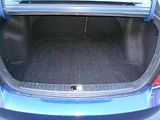
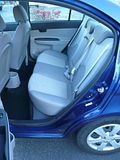
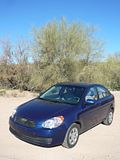

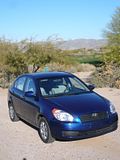

 Luxury is not the order of the day regardless of the trim variant selected. The entry level Blue car has to do without the option of an automatic gearbox, and the standard fitment of air conditioning, a tilt-adjustable steering wheel and rear wash wiper which all come on the GS model. GLS Sedans also gain an upgraded audio unit with XM Satellite reception as well as both an MP3 and Auxiliary adapter,each of which are located at the base of the central console. The SE Hatchback adds anti-lock brakes, remote central locking, power windows and mirrors, a sun roof, 16″ alloys, fog lights and sports suspension. The test car featured the optional Premium package which brings with it anti-lock brakes, cruise control, remote central locking, remote mirrors and audio unit functions on the steering wheel. Sadly the satellite radio subscription had clearly run out, so my delight in finding this feature in such a cheap car was short-lived when I tried to select it!. Although the GLS Sedan Automatic is not quite the bargain price that is headlined by the Blue, a retail listing of $14,645 for the GLS Automatic and a further $1050 for the Premium package means that this still one of the cheapest 4 door cars on the market, and it is noticeably roomier inside than competitors such as the Chevrolet Aveo.
Luxury is not the order of the day regardless of the trim variant selected. The entry level Blue car has to do without the option of an automatic gearbox, and the standard fitment of air conditioning, a tilt-adjustable steering wheel and rear wash wiper which all come on the GS model. GLS Sedans also gain an upgraded audio unit with XM Satellite reception as well as both an MP3 and Auxiliary adapter,each of which are located at the base of the central console. The SE Hatchback adds anti-lock brakes, remote central locking, power windows and mirrors, a sun roof, 16″ alloys, fog lights and sports suspension. The test car featured the optional Premium package which brings with it anti-lock brakes, cruise control, remote central locking, remote mirrors and audio unit functions on the steering wheel. Sadly the satellite radio subscription had clearly run out, so my delight in finding this feature in such a cheap car was short-lived when I tried to select it!. Although the GLS Sedan Automatic is not quite the bargain price that is headlined by the Blue, a retail listing of $14,645 for the GLS Automatic and a further $1050 for the Premium package means that this still one of the cheapest 4 door cars on the market, and it is noticeably roomier inside than competitors such as the Chevrolet Aveo.
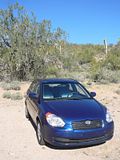
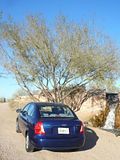
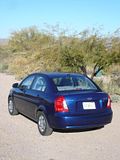
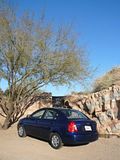

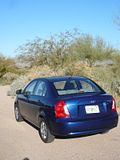
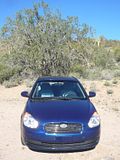 So, bottom of the automotive pile from a cost point of view, for sure, but not quite as purgatorial as you might fear. Of course there is no fun, and no real design flair in this car, but as cheap transport, it is perfectly fit for purpose, and for those who need to find the very cheapest rental car, they would be far better driving one of these than an Aveo. What will make things more interesting is that the 2012 car, available as a 4 door saloon and 5 door hatchback brings Hyundai’s latest fluidic styling to the class, and along with dynamic improvements represents something that bit better than pure utility transport. Doubtless these cars will appear in the rental fleets in due course,and the budget renter will get the chance to see how quickly standards continue to improve.
So, bottom of the automotive pile from a cost point of view, for sure, but not quite as purgatorial as you might fear. Of course there is no fun, and no real design flair in this car, but as cheap transport, it is perfectly fit for purpose, and for those who need to find the very cheapest rental car, they would be far better driving one of these than an Aveo. What will make things more interesting is that the 2012 car, available as a 4 door saloon and 5 door hatchback brings Hyundai’s latest fluidic styling to the class, and along with dynamic improvements represents something that bit better than pure utility transport. Doubtless these cars will appear in the rental fleets in due course,and the budget renter will get the chance to see how quickly standards continue to improve.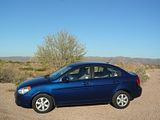
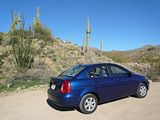
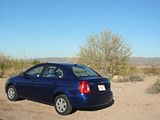
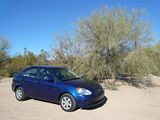
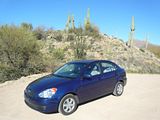

2012-02-04 11:12:03





















































